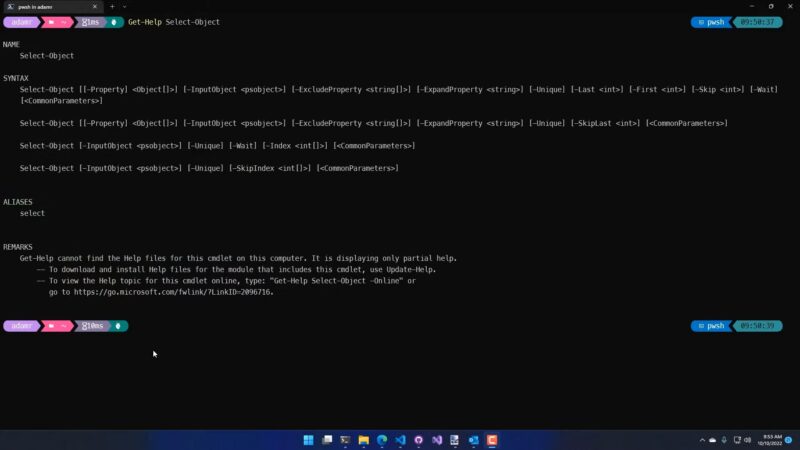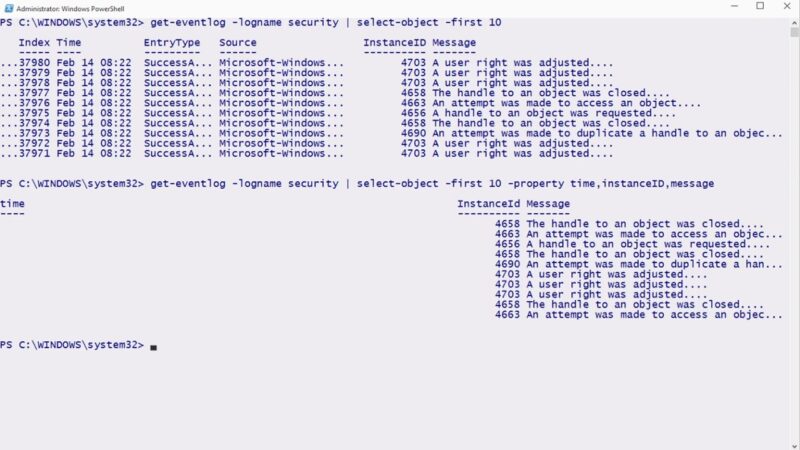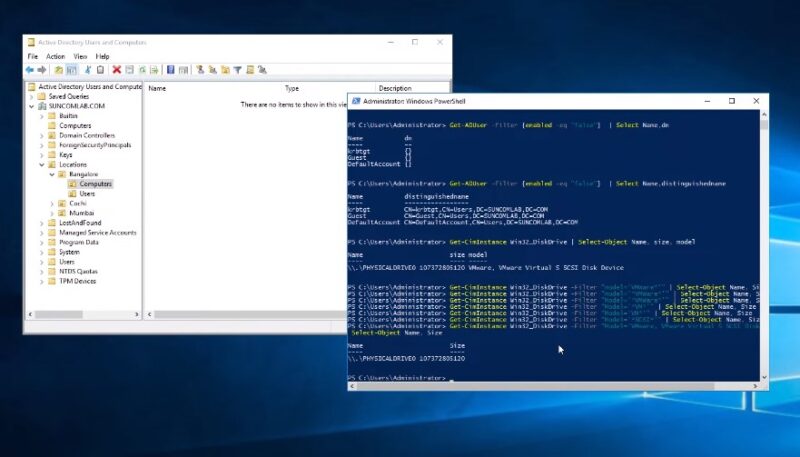Whether you’re an experienced developer or just a beginner, understanding this cmdlet can improve your skills in the PowerShell. Imagine you’re in a library, and you’re handed a book with thousands of pages.
But what if you only need a few specific pages from that book? Would you painstakingly go through each page, or would you prefer a tool that extracts just the pages you need? In the PowerShell library, Select-Object is that tool.
What is Select-Object?

Select-Object is a cmdlet in PowerShell that allows you to pick and choose specific pieces of information from a larger set. Think of it as a filter or a sieve, letting through only what you deem essential.
It’s like highlighting specific lines in a lengthy document, making it easier to focus on what matters. Even if you are not a pro developer, it can be a helpful way to learn more about different processes, especially when combined with a good handling of Task Manager.
Why Should I Use It?

In the realm of PowerShell, data can be overwhelming. There’s often more information available than what you might need.
Select-Object helps streamline this data, ensuring you get only the relevant bits. It’s about efficiency, clarity, and making your PowerShell experience smoother.
Advanced Features
While the basic use of Select-Object is simple, its applications can be vast and profound.
Complex Operations
While its primary function is to select specific data, Select-Object isn’t limited to just that. It can also:
- Modify the data you’re viewing, allowing for customized views.
- Sort and organize data in a manner that’s more digestible.
- Combine data from different sources, creating a unified view.
Fine-Tuning
Mastering Select-Object is about understanding its nuances. It’s not just about selecting data but selecting it in the right way. This involves knowing what to look for, how to look for it, and how to present it. It’s an art as much as it is a science.
Tips for Everyday Use
Every tool is only as good as the hands that wield it. Here are some insights to make the most of this system.
The Power of Precision
In the world of data, precision is key. Being clear about what you’re looking for can save time and avoid confusion. With Select-Object, being precise can lead to faster, more accurate results.
Embracing Flexibility
One of the beauties of Select-Object is its flexibility. It doesn’t box you into a specific way of doing things. Instead, it adapts to your needs, making it a truly user-centric tool.
Continuous Learning
The landscape of PowerShell is ever-evolving. As with any tool, the more you use Select-Object, the better you get at it. Embrace a mindset of continuous learning, and you’ll find yourself discovering new tricks and techniques regularly.
The Evolution of Select-Object

As with many tools in the tech world, Select-Object has evolved over time. Its journey is related to the broader evolution of PowerShell, reflecting the changing needs and demands of its user base.
The Beginning
When PowerShell first emerged, it was a revelation in the world of scripting and automation. As users began to explore its capabilities, there was a clear need for a tool that could filter and refine the vast amounts of data PowerShell could handle.
In its early days, it was a simple tool, primarily used for basic data selection.
Adapting to Modern Needs
As the tech landscape grew more complex, so did the demands on Select-Object. Users weren’t just looking to select data; they wanted to manipulate it, transform it, and view it in diverse ways.
Recognizing this, the developers behind PowerShell expanded Select-Object’s capabilities, making it the multifaceted tool we know today.
Real-world Applications
Understanding a tool is one thing, but seeing it in action brings its value to life. Let’s explore some real-world scenarios where Select-Object shines.
Data Analysis
Imagine you’re an IT administrator, and you’re handed a massive log file with thousands of entries. You need to identify specific patterns or anomalies. With Select-Object, you can quickly filter out irrelevant data, focusing solely on the entries that matter, making the task less daunting and more manageable.
Streamlining Workflows
For developers and system administrators, efficiency is paramount. Tasks that are repetitive and time-consuming can be a drain. By using Select-Object to automate and refine data-related tasks, professionals can streamline their workflows, saving time and reducing the potential for errors.
Enhancing Reports
In corporate settings, data often needs to be presented in reports. But raw data can be overwhelming for non-technical stakeholders.
With Select-Object, data can be curated and refined, ensuring that reports are clear, concise, and tailored to the audience.
What to Expect in the Future?

As PowerShell continues to grow and adapt, so will this invaluable cmdlet.
Dealing with Future Challenges
The tech world is in a state of constant flux. New challenges emerge, and old ones evolve. But with tools like Select-Object, users are well-equipped to navigate these challenges. Its adaptability ensures that it remains relevant, no matter what the future holds.
A Community Endeavor
One of the strengths of PowerShell, and by extension Select-Object, is its vibrant community. Users from around the world share tips, tricks, and insights, ensuring that knowledge is disseminated and the tool’s potential is fully realized.
Other Useful PowerShell Functions

Get-Command:
- This cmdlet is the go-to tool when you’re unsure about the commands available in PowerShell or when you’re looking for a specific cmdlet. By listing all available cmdlets, Get-Command acts as a directory, helping users navigate the vast array of functions in PowerShell. It’s especially useful for beginners or when exploring new modules.
Get-Help:
- Get-Help is the built-in manual for PowerShell. Whenever you’re uncertain about how a cmdlet works or need to see examples of its usage, this cmdlet comes to the rescue. By providing detailed information and examples for each cmdlet, Get-Help ensures that users have a comprehensive resource at their fingertips.
Get-Process:
- Monitoring system processes is a common task, and Get-Process makes it straightforward. This cmdlet provides a snapshot of all currently running processes, offering insights into resource usage, process IDs, and more. It’s an invaluable tool for system diagnostics and monitoring.
Get-Service:
- Services are background processes that play crucial roles in the functioning of an operating system. With Get-Service, users can quickly view the status of all services, checking if they’re running, stopped, or paused. This cmdlet is essential for system administrators managing server environments or diagnosing service-related issues.
Set–ExecutionPolicy:
- Security is paramount, especially when executing scripts. Set-ExecutionPolicy allows users to define the level of security regarding script execution. By setting policies like Restricted, AllSigned, or Unrestricted, users can strike a balance between flexibility and security, ensuring that scripts run in a controlled environment.
FAQs
Can I use Select-Object with other cmdlets besides Get-Process?
The beauty of Select-Object is its versatility. You can use it with virtually any cmdlet that produces output. Whether you’re working with Get-Service, Get-Item, Get-User, or any other cmdlet, Select-Object can help you filter and refine the output as needed.
How does Select-Object differ from Where-Object?
While both cmdlets are used for filtering, they serve different purposes. Select-Object focuses on selecting specific properties or a subset of the output. In contrast, Where-Object filters output based on specific conditions or criteria. Think of Select-Object as choosing columns in a table, while Where-Object is about selecting specific rows based on conditions.
Can I use Select-Object to reorder properties in the output?
Yes, you can! The order in which you list properties with Select-Object determines the order they appear in the output. For instance, if you want the ProcessName to appear before the Id, you’d use Select-Object ProcessName, Id.
Is there a limit to the number of properties I can select using Select-Object?
No, there’s no inherent limit. You can select as many properties as are available in the object you’re working with. However, for readability and clarity, it’s often a good idea to limit your selection to the most relevant properties for your task.
Are there performance considerations when using Select-Object on large datasets?
While Select-Object is optimized for performance, filtering large datasets can consume more memory and processing power. It’s always a good practice to be selective and use filters efficiently, especially when working with substantial amounts of data. This ensures that your operations remain swift and responsive.
In Conclusion
Select-Object is more than just a cmdlet in PowerShell. Whether you’re just starting your PowerShell journey or looking to refine your skills, understanding and mastering Select-Object can be a game-changer.
